Java vs Python for Business: Which Language Fits Your Strategy?

Java vs Python? If you plan to launch a new product or modernize a legacy system, this dilemma appears early, and the wrong choice can cost you months of rework, drain your hiring budget, or cap your platform’s future scalability.
Both languages boast proven records behind world‑class platforms, yet they solve different problems. Java offers structure, performance, and maturity. Python delivers speed, flexibility, and the fastest route to market. The best choice hinges on your architecture, budget, and growth targets. In product development services, that first fork defines the technical foundation for years to come.
This article breaks down the Java vs Python debate through a business lens: from long-term maintenance to MVP speed, team availability to cloud performance. Whether you’re a CTO who sets backend direction, a founder who plans to scale, or a consultant who advises clients, you’ll leave with a clear, grounded view on when each language makes sense.
Overview: What are Java and Python?
In any serious Python vs Java comparison, context matters. These two languages often appear side by side on shortlists, but they were never built for the same goals.
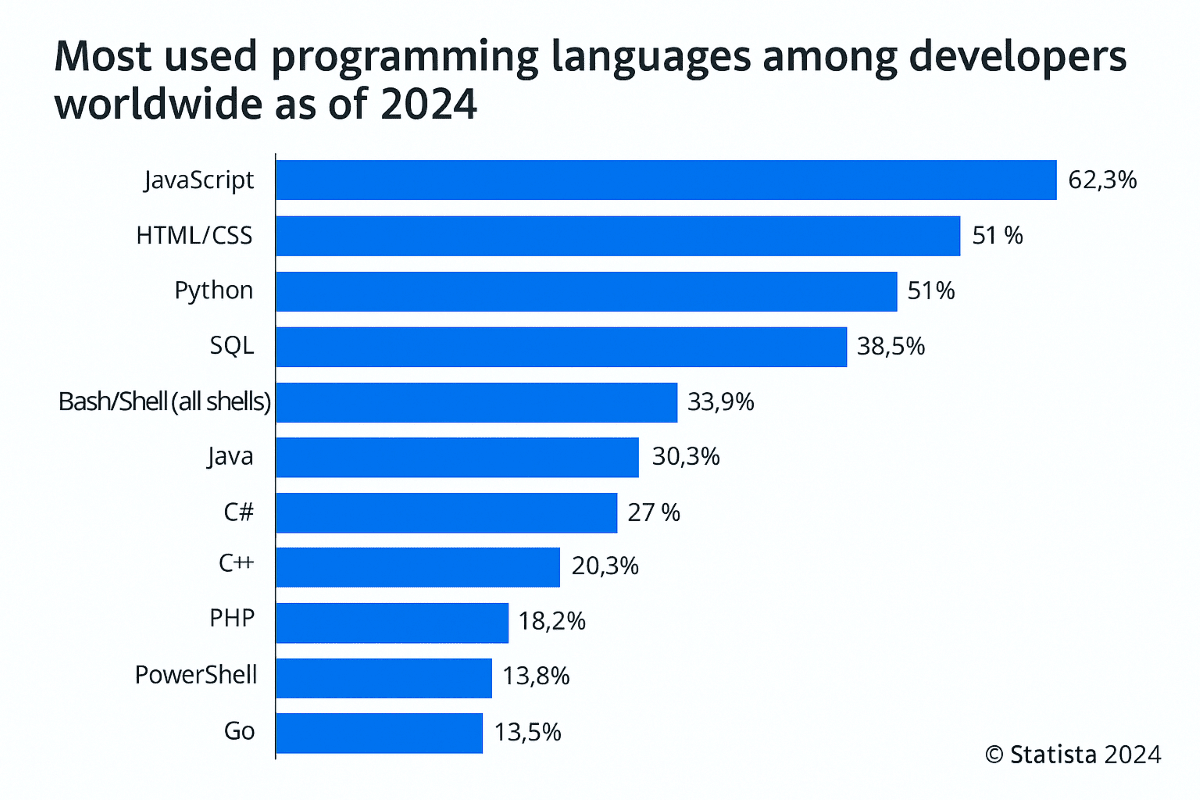
Source: Statista
Java arose in the mid‑1990s at Sun Microsystems to deliver platform‑independent code across embedded devices and enterprise grids. Compiled binaries, strict typing, and rigid architecture create predictability—an asset that keeps Java at the heart of banking, telecom, and other arenas where performance, security, and nonstop uptime outrank novelty.
Python, released a few years earlier by Guido van Rossum, emerged from scripting roots. Clear syntax and an exceptionally low entry barrier soon turned it into a general‑purpose favorite. Startups validate ideas with it first; data scientists rely on it for research; AI teams choose it for model development and deployment speed.
Technically, the divide stays simple. Java compiles the entire codebase upfront and forces explicit type declarations, which locks structure and reliability into place. Python interprets code line by line and infers types on the fly, granting teams rapid feedback and greater flexibility—ideal for experimentation and quick iteration.
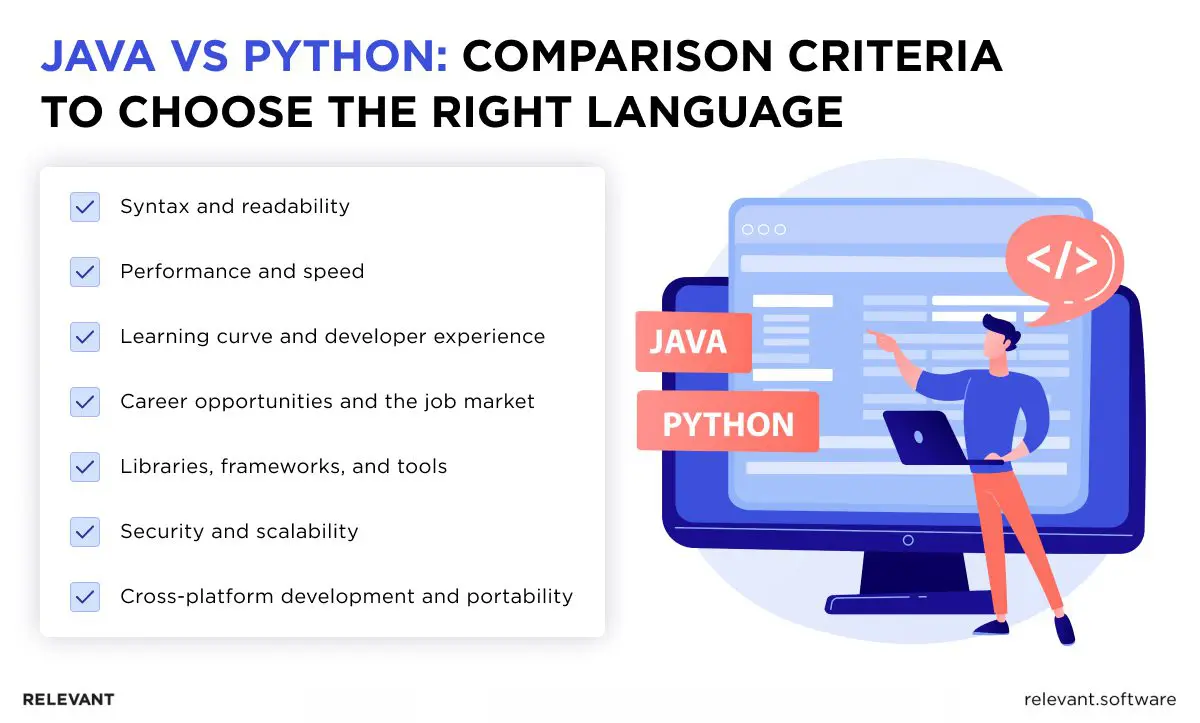
Syntax and readability
Understanding the difference between Java and Python often starts with how the code feels. Syntax isn’t just a developer’s concern: it shapes onboarding speed, code quality, and how quickly new teams can ramp up on your product, as it can affect the number of lines of code written. If your business expects rapid iteration or frequent team changes, readability matters as much as runtime performance.
Java syntax: verbosity and structure
Java favors precision. You have to clearly define the type of every variable, use braces for every block of code, and write out classes in full. While this often feels verbose, especially compared to modern script-based languages, it also enforces discipline. You’re less likely to get unexpected errors while the program is running because most issues show up during compilation.
This verbosity becomes an advantage in large, distributed teams. A strict structure helps engineers stay aligned, removes ambiguity, and supports long-term maintenance. But in fast-paced projects, especially MVPs, that same structure can slow progress. Teams often waste more time writing repetitive setup code than building the actual features users care about.
Python syntax: simplicity and clean code
Python code reads almost like English. Its cleaner, more concise syntax enhances clarity and reduces boilerplate: no curly braces, no semicolons, and no required type declarations. Its design philosophy, “There should be one, and preferably only one, obvious way to do it,” encourages consistency and brevity.
For new or cross-functional teams combining backend, AI, and data processing, Python lowers the barrier to entry. Onboarding takes less time. Code reviews move faster. And because indentation drives structure, even loosely written code tends to stay readable.
This simplicity, however, comes with trade-offs. Python’s dynamic typing can delay error detection until runtime, which may cost a lot of time in larger systems. Still, for early-stage products, analytics tools, or platforms built around data workflows, it’s often the best choice when speed and collaboration matter most.
Performance and speed
Once code moves from a developer’s laptop into production, performance becomes a critical concern. Syntax may shape team speed, but runtime efficiency determines how well your product scales and how much infrastructure it consumes.
Java’s JVM and compilation advantage
Java compiles code to bytecode, which then runs on the Java Virtual Machine (JVM). This adds a layer of abstraction between your app and the hardware, but it also unlocks a major performance edge. The JVM optimizes execution at runtime, using just-in-time (JIT) compilation to adapt to real-world usage patterns.
In Java vs Python vs C++ comparisons, Java sits between the two extremes. It offers better performance than Python and easier development than C++. This balance makes Java a strong fit for high-load platforms such as payment processors, trading systems, and backend APIs that support millions of users.
Python’s interpreter and speed tradeoffs
Python runs on an interpreter and processes code one line at a time. This allows quick testing, fast iteration, and simple prototyping. However, it also introduces performance limits, especially in CPU-heavy operations, due to the global interpreter lock. Python does not perform runtime optimization like Java, and its dynamic type system adds additional overhead.
Even though Python isn’t the fastest language, that’s usually not a big problem. In real-world apps, the parts that need to be fast often use pre-compiled tools like NumPy, TensorFlow, or Cython. These handle the heavy lifting efficiently, while developers still get to enjoy Python’s simple and easy-to-read code.
When performance truly matters
If your application must serve thousands of requests per second, process large data streams, or execute low-latency operations like fraud detection or market trades, Java often performs better. Benchmarks from TechEmpower and independent GitHub tests consistently place Java frameworks such as Spring and Vert.x ahead of Flask and Django in throughput.
However, in web environments where bottlenecks result from network latency, database queries, or third-party APIs, as is common in SaaS platforms and MVPs, Python performs well enough. In these cases, team velocity, fast releases, and product adaptability often carry more weight than pure execution speed.
The real Java vs Python performance tradeoff depends on where the bottlenecks appear and how much technical debt your business can absorb in exchange for faster iteration.
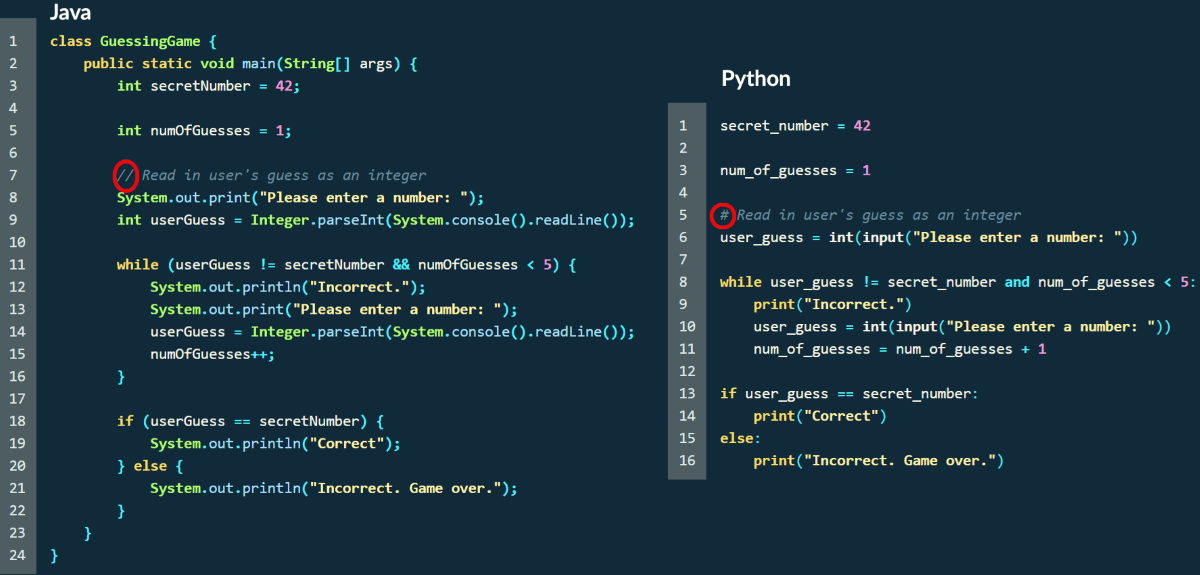
Source: Python
Learning curve and developer experience
The right programming language is not just about what it can do. It also affects how quickly your team can learn, build, and troubleshoot. The learning curve shapes team ramp-up, delivery pace, and how confident engineers feel when they release updates.
Ease of learning: Python’s advantage for beginners
Python programming is often the first programming language developers encounter, and for good reason. Python is easy to read because its code looks a lot like plain English. It skips the curly braces, cuts down on repetitive code, and doesn’t require you to say what type each variable is. For teams that need to move fast or bring on junior developers, Python, one of the most popular languages, provides a smoother path forward.
This accessibility also allows faster trial and iteration. Data scientists, analysts, and even product managers without formal coding experience can contribute directly. In early-stage software projects or cross-functional environments, that level of access can make a real business difference.
Java’s steeper learning curve but strong discipline
Java programming doesn’t try to be simple. It demands more from developers: explicit types, interface declarations, and structured class hierarchies. For beginners, this can feel overwhelming. But that structure creates benefits down the line: fewer runtime surprises, clearer architecture, and better compatibility with large-scale systems in enterprise development projects.
Experienced engineers often appreciate Java’s discipline. It enforces design patterns, encourages modularity, and aligns well with robust IDEs like IntelliJ and Eclipse. These tools streamline Java coding, static analysis, and integration into CI/CD workflows, particularly in cloud development environments.
Documentation, IDEs, and debugging support
Both programming languages benefit from mature ecosystems. Java offers enterprise-level tools. IntelliJ IDEA, Eclipse, and NetBeans provide advanced refactoring support and powerful debugging features. Python relies on lighter IDEs such as PyCharm and VS Code, well-suited for scripts and web apps.
Documentation remains strong for both. The Java community tends to follow a formal, specification-based approach. Python communities prefer quick-start guides, practical examples, and hands-on tutorials. Either way, your team can work efficiently with modern developer tools. And truth be told, Python often allows teams to move faster in the early stages.
Career opportunities and the job market
Beyond technical fit, a language choice also affects your hiring strategy. Availability of talent, competition for top candidates, and salary expectations all factor into team planning and project budget.
Job demand
Java developers remain in strong demand, especially in enterprise consulting, banking, and Android app development. Many large organizations still depend on long-running Java systems. This keeps Java development services relevant across financial, telecom, and enterprise sectors.
Python, meanwhile, has exploded in popularity, particularly in roles tied to machine learning applications, automation, and data analysis. As more companies adopt AI-first strategies, Python development services now play a core role in product development.
While job boards show similar demand for both roles, the focus often differs. Java maps to traditional backend development in structured environments. Python appears more often in cross-functional product teams that support experimentation and data-focused tools.
Average salaries and industry trends
Salaries vary by region and industry, but recent benchmarks show Python developers tend to earn slightly more on average, especially in AI, finance, and cloud computing roles. In the U.S., for example, Python developers report annual salaries between $115k–$140k, while Java developers fall closer to $105k–$130k, depending on experience.
That said, Java specialists with deep knowledge of enterprise systems or Android often secure higher rates, especially in industries that continue to rely on Java-based infrastructure.
From a hiring standpoint, Python offers broader talent access and greater adaptability, which suits startups and hybrid teams. Java, by contrast, connects companies with engineers who hold formal backgrounds in software engineering — often a better match for teams that build large, scalable systems.
Libraries, frameworks, and tools
Behind every successful app is an ecosystem, not just the language. The real advantage often comes from the tools your team uses every day: frameworks, libraries, and how well everything fits into your workflow. That’s where Java and Python start to feel very different.
Java libraries and frameworks
Ask any senior Java developer what tools they use, and you’ll likely hear “Spring.” It has served as the primary framework for years, offering clean structure, strong reliability, and excellent support for secure backend services. When paired with Hibernate for database access, Java becomes a strong choice for enterprise-level software development.
Teams also turn to Vert.x for high-performance needs or Quarkus to support lightweight services that run in containers. In banking, telecom, and other fields with complex architecture, Java’s ecosystem has already addressed many of the difficult technical challenges. That leads to faster delivery, even though the initial learning curve may feel steep.
Python libraries and frameworks
Python is an interpreted programming language, and that flexibility shows in how teams use it. In one project, a team might use Django to launch a web platform with admin, ORM, and authentication already built in. In another, they might use PyTorch or TensorFlow in the world of AI or apply Pandas and NumPy for big data analysis in data science.
Python’s ecosystem spans far beyond one niche. It powers automation tools, analytics pipelines, lightweight web applications, and even early-stage mobile app development. This wide reach, backed by extensive libraries and fast-growing community support, makes Python one of the most popular programming languages used for AI today, particularly for rapid MVPs and internal tools.
Tooling and DevOps fit
Java supports robust CI/CD pipelines. Legacy and modern teams alike continue to rely on Jenkins, Maven, and Gradle: tools that help standardize builds, manage source code, and integrate with complex backend systems. For projects that involve multiple services or strict compliance, Java’s structure and predictability offer long-term value. It’s one reason Java remains popular in enterprise DevOps environments.
Python takes a lighter, faster approach. GitHub Actions and GitLab CI allow teams to launch pipelines quickly, with less configuration. Packaging and deployment move faster, especially for teams focused on web development, cloud automation, or data workflows. Python supports fast iteration, making it ideal for teams that work across disciplines or adapt rapidly to new requirements.
Both ecosystems scale well in the cloud and work across different operating systems. The distinction lies in rhythm — Java brings control and consistency, while Python supports momentum and agility.
Comment from Relevant Software experts: From a DevOps standpoint, Java vs Python for web development depends on what your system demands. Java suits larger systems with high compliance needs. Python fits lean teams focused on speed and experimentation.
Security and scalability
When you’re building software meant to last, or one that handles sensitive data, syntax flashiness takes a back seat. What really matters is how your tech stack behaves under pressure, and how reliably it protects systems, users, and information when something breaks.
Java in secure, scalable environments
By default, Java includes strong protections: strict static types, detailed permission controls, and runtime enforcement through the JVM. Paired with frameworks like Spring Security, it forms a stack that meets enterprise-grade compliance without extra layers.
Scalability also stands out. Java supports virtual machines, cloud-native containers, and orchestration tools like Kubernetes. Major cloud platforms such as AWS and Google Cloud offer dedicated support for Java workloads. For systems that serve millions and demand long-term stability, Java often proves the best choice.
Python’s role in rapid prototyping (and what comes after)
Python shines in the early stages. But as the user base expands and complexity increases, Python’s flexibility turns into a double-edged sword.
Dynamic types introduce risk. Using dynamic types can be risky, as mistakes in the code might not show up until you actually run it. Because the code is interpreted as it runs, it can also be slower, especially when doing a lot of complex calculations.
Security in Python rests heavily on the team. The language lacks strict enforcement by default. Errors like dependency confusion or unsafe deserialization often slip through. Still, with tools like Bandit, Safety, Django’s built-in controls, and disciplined processes, teams build secure systems in Python.
Many Relevant Software clients use Python for services powered by cloud platforms and microservices. In these setups, Python’s weaknesses get mitigated by smart architecture, and its speed keeps teams moving forward.
Security best practices (for both)
Neither Java nor Python guarantees safety out of the box. But both give you what you need, if you use them. Here’s what experienced teams do in either case:
- Run dependency scans early and often (OWASP Dependency-Check for Java, Safety for Python)
- Lock down access control, encrypt everything sensitive
- Keep libraries patched, especially open-source ones
- Build security checks into your CI/CD process, not after it
Comment from Relevant Software engineers: If your product processes payments, patient data, or any mission-critical information, Java delivers more structure and built-in control. But for lean teams and aggressive release cycles, Python delivers rapid iteration and a lower entry barrier, provided the team addresses performance bottlenecks, enforces strict tests, and sets clear module boundaries.
Cross-platform development and portability
Your language choice shapes how smoothly a product expands across mobile, desktop, cloud, or embedded targets. In product development services, portability often dictates timelines and long‑term costs. The key differences between Python and Java become most visible here, from runtime behavior to mobile support and tooling maturity.
Java’s “Write Once, Run Anywhere” promise
This has been Java’s tagline since day one, and despite how much the industry has changed, it still mostly holds true. Java code compiles to bytecode, which runs on the Java Virtual Machine (JVM). That abstraction layer means your application can run consistently across Windows, Linux, macOS, or even Android with minimal changes.
In practice, this reduces overhead. A backend service written in Java can move between on-prem servers and cloud development platforms like AWS or Azure without major rewrites. Enterprise teams appreciate this because it allows infrastructure flexibility over time, which becomes valuable as companies grow or pivot.
And in Android development, Java still plays a foundational role. While Kotlin has taken the lead, most Android apps, especially older or enterprise-grade ones, still rely heavily on Java libraries and tooling.
Python’s compatibility and limitations
Python works across platforms. It runs on most modern operating systems, and teams can move scripts and applications between machines with minimal effort. However, its portability comes with limitations.
Because Python runs through an interpreter, version mismatches and dependency issues can surface unexpectedly. A script that runs cleanly in one environment may fail elsewhere due to subtle configuration differences. Tools like virtual environments and Docker reduce these risks, but they introduce setup overhead, especially for teams without strong DevOps capabilities.
Python also falls short in mobile or embedded development. Frameworks like Kivy or BeeWare exist, but they lack the maturity and support that Java or Kotlin provide on Android. For cross-platform desktop tools or lightweight automation, Python performs well. For complex, high-performance mobile apps, it remains a secondary option.
Comment from Relevant Software experts: Python relies on separate libraries that you install on each machine. If those library versions differ, even by a minor update, the app may work on a developer’s laptop but crash in production. Java, by contrast, bundles its libraries inside the final build, so every environment runs the exact same code and avoids that surprise.
When to use Java vs Python (decision guide)
If you still ask Java vs Python which is better, the answer usually depends less on code and more on business context. The best language is the one that fits your constraints: product goals, team composition, delivery timeline, and long-term strategy.
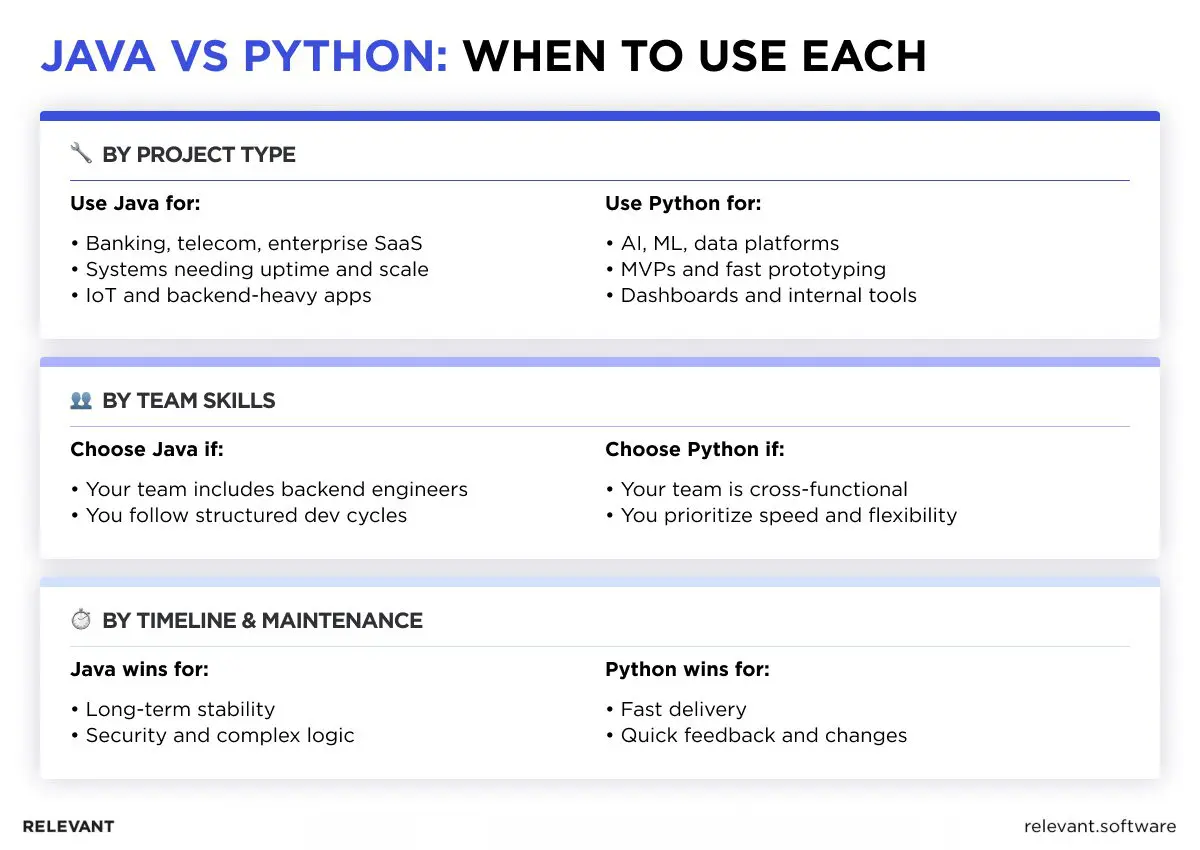
Based on project type
For high-stakes, large-scale systems, especially in banking, telecom, or enterprise SaaS, Java stands out. Its strict type system, robust frameworks, and optimized JVM performance make it a top choice for applications that demand reliability, uptime, seamless scale, and backend integration with Internet of Things platforms.
For data-focused platforms, machine learning features, or MVPs with tight timelines, Python offers a clear advantage. It enables rapid experimentation, reduces initial setup effort, and allows teams to shift direction quickly. Whether it’s a web app, an internal dashboard, or an AI-powered feature, Python supports fast delivery without unnecessary overhead.
Still unsure? Here’s a quick rule of thumb, confirmed by Relevant Software developers:
- Choose Java for transaction-heavy systems with long life cycles
- Choose Python for rapid iteration, AI-driven tools, and MVPs that evolve over time
Based on team skills and resources
Language choice often depends as much on people as on syntax. If your developers know Java architecture or you plan to hire for backend-heavy roles, Java aligns with structured engineering workflows. It supports consistent code practices and stable development phases, which helps on larger or more regulated projects.
Python compared to Java draws a more diverse talent pool — data scientists, automation engineers, and domain experts without formal CS backgrounds. For cross-functional teams or companies that move fast in sectors like health tech or SaaS, Python offers more flexibility and often enables quicker team ramp-up.
Comment from Relevant Software experts: Python has a wide talent pool, especially among junior engineers. Java developers often bring deeper experience with enterprise-grade systems.
Based on time-to-market and maintenance
When speed matters and you need to reach a product–market fit quickly, Python offers a clear advantage. Its simplicity, smaller codebase, and intuitive syntax help teams ship features, collect feedback, and adapt without added complexity.
Once the product grows and begins to face security demands, performance bottlenecks, or intricate business rules, Java starts to show its strength. Its structure allows for greater stability, more consistent maintenance, and smoother long-term scaling.
Comment from Relevant Software experts: In short, the advantages and disadvantages of Java vs Python depend on what you optimize for — stability or speed, scale or experimentation, strict process or lightweight delivery. Each language works. The challenge is picking the one that works best for your stage, team, and market.
Java vs Python comparison table
If you need a quick way to compare their trade-offs across performance, scalability, hiring, and use cases, the table below gives a clear side-by-side view to support your decision.
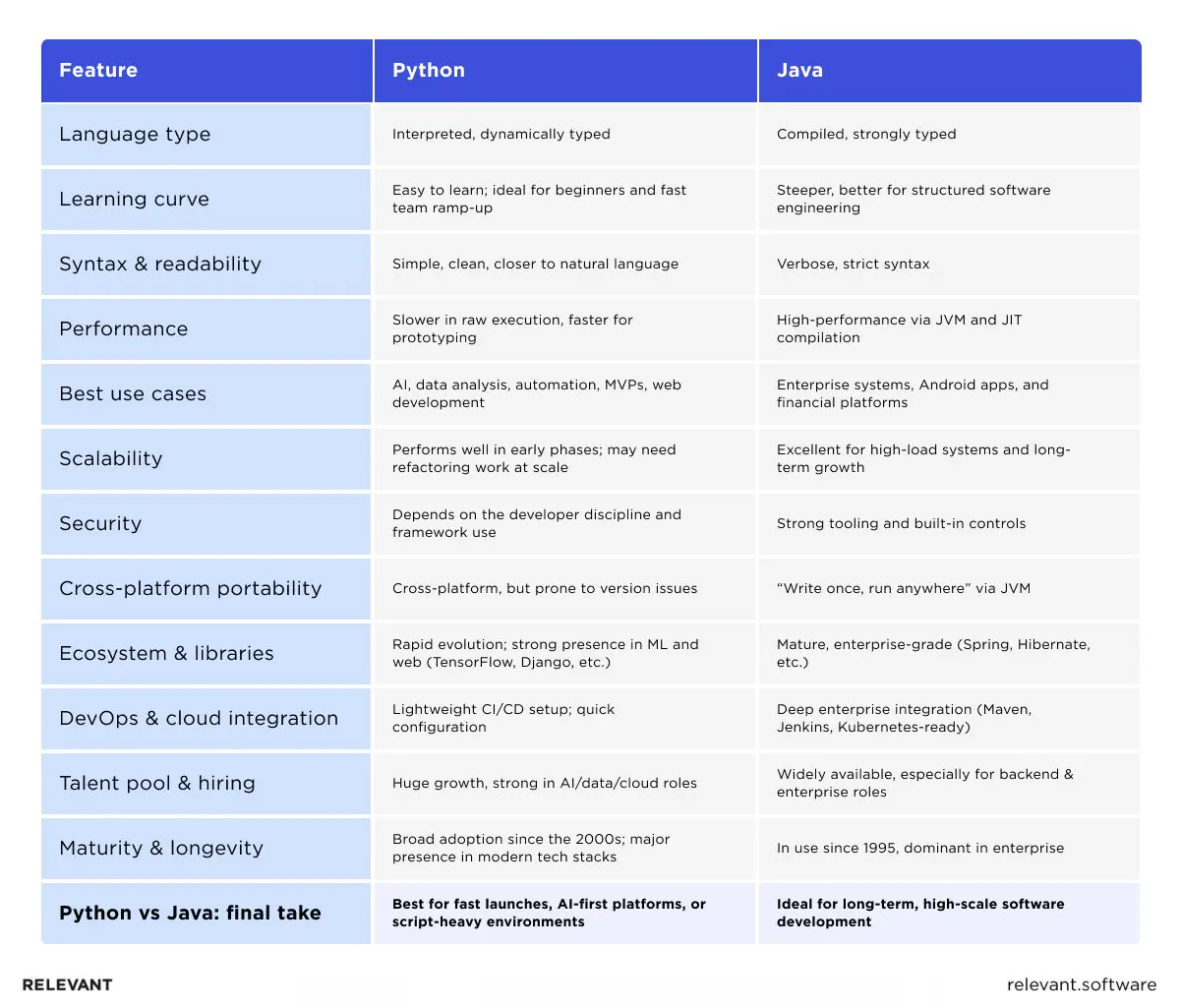
Our case studies: How clients win with Java vs Python at Relevant Software
Across dozens of enterprise launches, Relevant Software builds in Java and Python that now secure $4 trillion in annual trades and answer complex data questions in under a second. Results, not theory, guide every language choice.
Java in action: scalable fintech infrastructure
A UK‑based post‑trade platform served more than 500 financial institutions, yet still depended on scattered email threads to resolve settlement breaks. The firm needed a single, auditable system that enforced strict security rules while handling thousands of messages per hour.
Relevant Software joined as a dedicated backend partner and built a Java core that:
- Converts inbound emails into structured workflow tickets.
- Routes tasks in real time to the correct custody, brokerage, or clearing team.
- Preserves every step for audit and regulatory review.
- Runs on AWS with redundant zones to guarantee 99.9 % uptime.
- Includes 400 + automated tests that cut QA overhead by 35 %.
Today, Java backbone drives mission‑critical operations for custodians, brokers, and clearing houses worldwide, and scales effortlessly as new institutions join.
Python in action: AI-powered data access agent
As an AI development company, Relevant Software is building a Python-based agent that connects directly to a client’s database, understands natural language queries, and returns accurate SQL responses instantly.
The solution now includes user-level authorization, context-aware query rewriting, and a working demo interface. We continue to refine its performance to deliver fast, precise answers. Built for clients who need intelligent, secure access to structured data, the project remains in active development with long-term white-label plans.
Python vs Java: Which language should your business choose?
No single answer covers every situation in these debates. Each language offers distinct strengths and supports different priorities based on your business goals.
For high-performance, secure systems built to last and serve millions, Java remains a strong choice. It brings structure, reliability, and seamless alignment with enterprise workflows.
For teams that must move fast, launch prototypes, apply machine learning, or explore new business models, Python offers clear advantages. It feels lighter, adapts quickly, and shortens the time to release.
In the end, alignment matters most. Choose the language that fits your team’s strengths, supports your product’s needs, and matches your growth trajectory. The best choice depends less on syntax and more on long-term fit.
Still unsure? Contact us — we’ll help define the right foundation for your next product.



